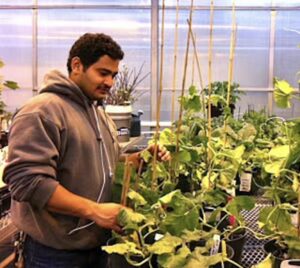David Perla is a graduate student in the Department of Plant Soil and Microbial Sciences at Michigan State University and is working on a PhD under the guidance of his major professor, Dr. Mary Hausbeck and committee members Dr. Raymond Hammerschmidt, Dr. Jan Byrne and Dr. Zachary Hayden.

David working with cucurbits in the greenhouse. Image courtesy of the Hausbeck Lab at MSU.
What is your hometown?
Sonaguera, Colon Honduras
What is the focus of your work?
Plant Pathology
Introduce yourself, your background, where you are now, and your current research focus.
I am originally from Honduras. I have a B.S. in Agriculture from the National University of Agriculture in Honduras and an M.Sc. in nematology from Purdue University. After 13 years of working as a nematologist for the Honduran foundation for agriculture research (FHIA), I Joined the Hausbeck Lab in 2018 as a Graduate Student Investigating strategies to manage Phytophthora spp. on vegetables in Michigan. In the last few years, I have been investigating the resistance of hard squash cultivars to Phytophthora capsici.
Why did you choose to work with Cucurbits and Plant Pathology?
In Michigan, the cucurbit crops represent a significant component of agricultural production. However, most of the cucurbit crops grown in Michigan are vulnerable to plant diseases that represent a major concern for the growers, e.g., Phytophthora blight caused by Phytophthora capsici. I chose to work on investigating the management of Phytophthora blight of cucurbits to collaborate with the industry to efficiently, economically, and in an environmentally friendly way solve one of the major problems that growers face every season.
What do you hope to accomplish during your time working on the CucCAP grant, and what do you most look forward to in this position?
Short-term, with the results of my research, I aim to help the project identify sources of resistance to Phytophthora blight that are commercially available to the growers and that can be implemented as part of an integrated disease management program. As a long-term objective, I hope I can learn from all the experts that are working on the project, expanding my networking that could help me in the future to find a job position from where I can continue working on diseases of cucurbits.
Please provide a brief description of your research.
We compared commercial cultivars for crown rot susceptibility and evaluated select fruit characteristics relevant to processing including mesocarp soluble solids [degrees Brix (°Brix)], percent dry matter, and average fruit weight. Four Butternut types (Cucurbita moschata), two Delicious varietal Hubbard types (Cucurbita maxima), and six Kabocha types (C. maxima) were evaluated for crown rot resistance (2020, 2021) and fruit characteristics (2019, 2020). To evaluate crown rot, plants were inoculated in replicated field trials. The C. moschata cultivars Dickinson, Buckskin, New England Cheddar, and Ultra Butternut had significantly less plant death for both years (<15%) than other cultivars. Significantly fewer ‘Thunder’ plants died in 2020 (59.6%) and 2021 (76.9%) compared to the industry standard ‘NK 580’ (>90.0%), ‘Golden Delicious’ (>88.5%), ‘Sweet Mama’ (>94.2%), ‘Delica’ (>92.3%), and ‘Sunshine’ (>90.4%). In non-inoculated field trials, mature fruits were assessed for fruit characteristics. Of the resistant C. moschata cultivars, only ‘Ultra Butternut’ exhibited similar or greater °Brix than ‘NK 580’ in both years and had comparable dry matter and fruit weight. Kabocha cultivars with moderate crown rot susceptibility (i.e., ‘Thunder’) exhibited higher °Brix and dry matter and smaller fruit weight than ‘NK 580’ each year. Integrated management programs can be advanced by selecting cultivars with crown rot resistance. Further evaluation of desirable yield and quality characteristics could accelerate acceptance of cultivars with resistance to crown rot by growers and processors.
What is your favorite crop, gene, pathogen or plant disease?
The patho-system Squash-Phytophthora capsici is my favorite.
Do you have any social media handles that you want included?
Linkedin: david-perla-9a837b69
Twitter: @edgardoperla.
